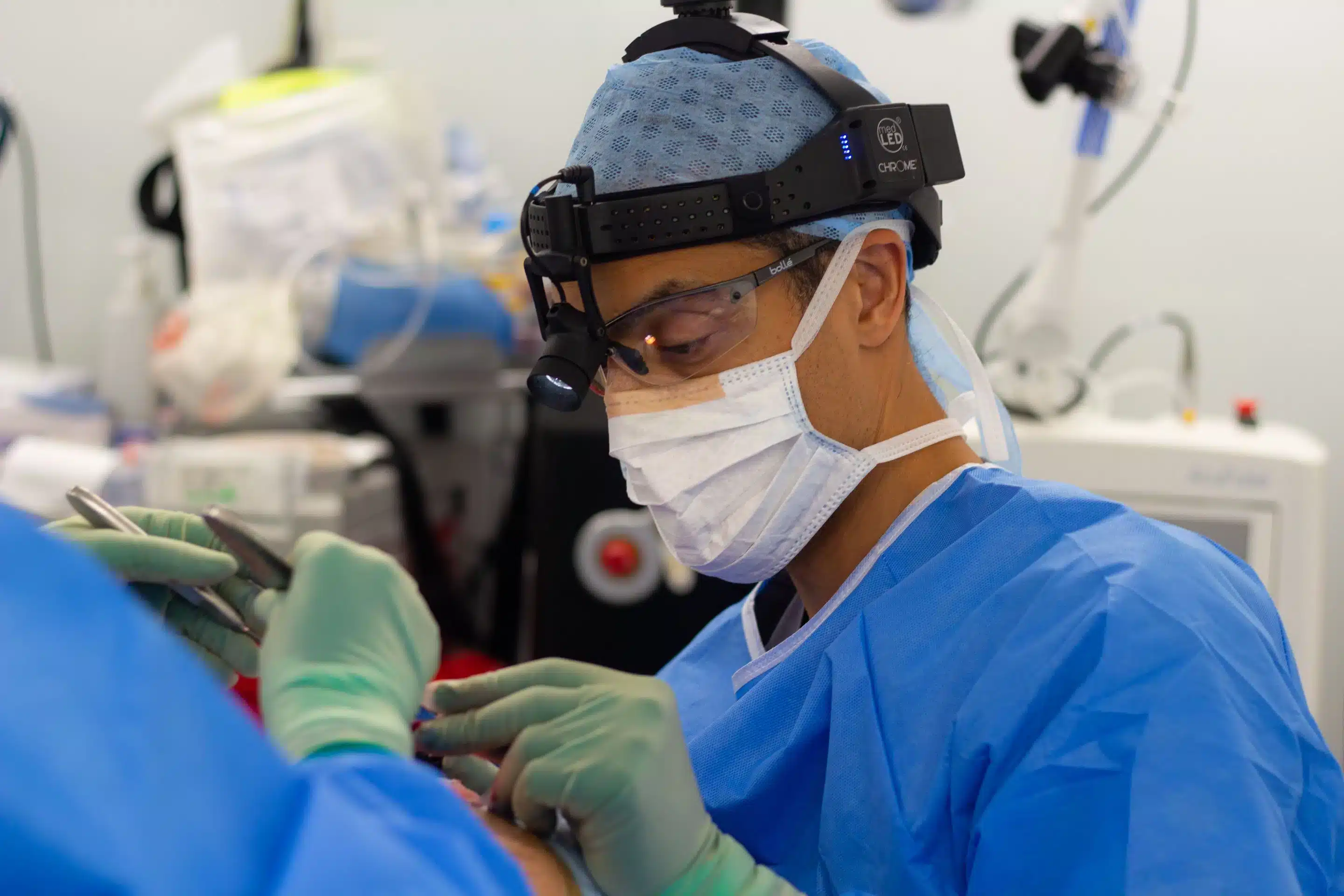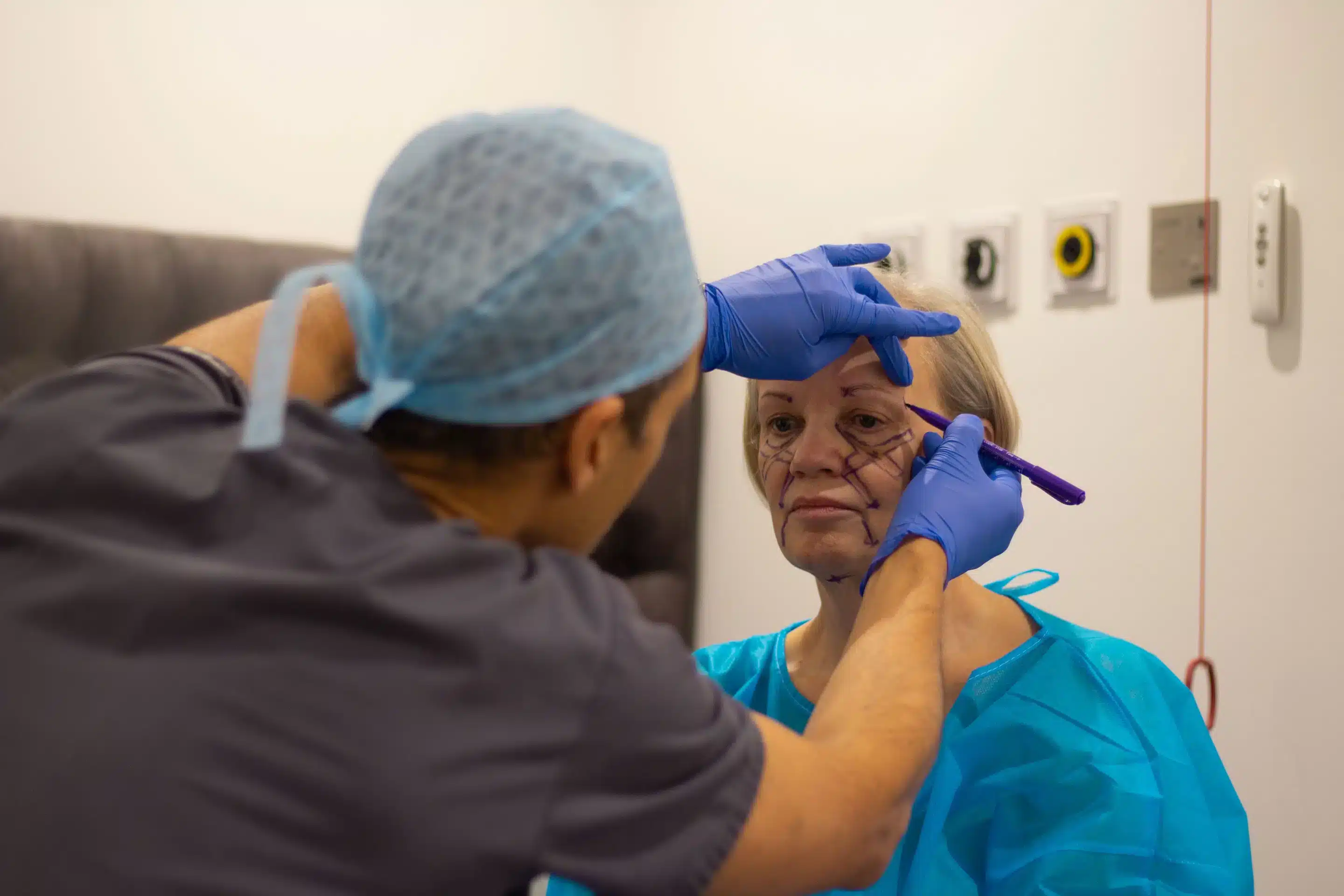
Facing the mirror to find a fuller face than you’d like is a common concern among ageing people. Genetics, age, and lifestyle factors all play a role in this.
Fortunately, there are proven ways to address it. In this article, we’ll explore the underlying causes of facial fat (e.g. double chin) and how you can reduce them. So, buckle up for a transformative journey to achieve the chiseled, slim face you’ve been aspiring for.
Does Face Fat Go Away?
Yes, face fat can decrease, usually through overall weight loss that causes reduced body fat. People ideally lose weight through a healthy diet, regular exercise, and good sleep. Lifestyle adjustments like reducing sugar intake and alcohol consumption can also help. In a few cases,
However, genetics and age, which influence face shape and skin elasticity, can make this process more challenging for some.
What Causes Face Fat?

Weight Gain
Generally, gaining weight can also lead to a fuller face as the fat gets distributed throughout your body, including the face.
Fluid Retention
Consumption of excessive salt and alcohol or dehydration can cause your body to retain water, leading to puffiness or swelling, including on the face.
Poor Diet
High-calorie, high-fat, and processed food can make you gain weight and potentially increase facial fat.
Lack of Aerobic Exercise
Regular physical activity helps you maintain a healthy weight. On the other hand, lack of exercise can contribute to weight gain and increased facial fat.
Genetics
Some people may naturally have a rounder face or carry more fat in their faces due to genetic predispositions.
Age
As we age, we lose collagen and elasticity in our skin, causing it to sag and often making the face appear fuller.
Remember, everyone is unique and these factors can affect individuals differently. If you’re concerned about facial fat, consider consulting with a healthcare professional to discuss healthy ways to address it.
Do Facial Exercises for Facial Muscles Work?

Facial exercises, also called face yoga, aim to tone facial muscles and enhance contours. Some limited research, like a 2018 study in JAMA Dermatology, suggests these exercises can help middle-aged women appear younger and more toned.
However, facial exercises are not a quick fix for fat reduction. Moreover, their results are usually subtle and take time. As always, consult with a cosmetic doctor like Dr. Julian De Silva for safe practice.
Can You Get Rid of Facial Fat if You Lose Weight?
Yes, losing weight generally leads to less facial fat. Weight loss occurs throughout the body, including the face.
So, if you lose weight through a healthy diet and regular cardio exercise, you’ll likely notice a decrease in facial fat over time. However, the extent of facial slimming varies from person to person, as factors like genetics and age can influence face shape and fat distribution.
How To Get Rid of Face Fat

While lifestyle modifications and weight loss can lead to reductions in facial fat, these methods might not provide the results some individuals are seeking, especially if genetic factors, bone structure, or age-related changes are influencing the face’s appearance. In such cases, surgical procedures are more effective.
The most common surgical solution to get rid of facial fat is buccal fat removal or cheek reduction surgery. This procedure involves removing the buccal fat pads in your cheeks, which can lead to a more defined and contoured face.
If you want to remove your double chin, surgical procedures can help. In particular, a facelift can remove your double chin. Surgical double chin removal can also help, but it’s solely for the double chin. It’s a relatively straightforward procedure for the double chin performed by a plastic surgeon, usually under anaesthesia.
Another option is liposuction of the face, which can effectively remove excess fat and offer a more sculpted facial contour. It’s important to note that any surgical procedure carries potential risks, such as infection, scarring, and anaesthesia complications, and therefore, must be carefully considered.
Get Rid of Face Fat Accumulation With Cosmetic Surgery
Cosmetic surgery offers a definitive approach to getting rid of facial fat, and one of the most effective procedures for this purpose is a facelift.
A facelift (also known as rhytidectomy) is a surgical procedure that can significantly reduce the appearance of skin laxity and excess fat. It is done by a qualified cosmetic surgeon. The treatment works by excising excessive skin, tightening the tissues and muscles underneath, and repositioning the skin.
Why Get a Facelift?

A facelift, combined with a neck lift, can help decrease facial fat and address issues like a double chin.
It makes the face look younger by pulling tight the loose skin and getting rid of extra fat, especially around the chin and neck.
It gives a fresh, younger look by reducing wrinkles. The best part? The effects of a facelift can stay with you for ten years or even longer, making you feel more confident.
Moreover, each facelift is designed to match what you need and want for your appearance.
Mini Facelift for Losing Facial Fat
A mini facelift is a less invasive cosmetic surgery procedure that targets the middle to lower face, including the cheeks, jawline, and neck. It’s often considered by individuals who want to address mild sagging and excess fat in these areas without undergoing a full facelift.
The procedure involves smaller incisions, usually around the ears, through which the surgeon tightens the underlying muscles and removes or repositions excessive fat. This leads to a more defined and youthful facial contour, specifically around the jawline and neck.
The benefits of a mini facelift include a shorter surgery time, quicker recovery, and less scarring compared to a full facelift. However, it’s most effective for individuals with moderate signs of ageing; those with significant sagging and loose skin might still require a traditional facelift for optimal results.
Thread Lift for Losing Facial Fat

The procedure is sometimes referred to as a lunchtime facelift due to its quicker process and recovery time compared to traditional facelifts.
During a thread lift, a cosmetic surgeon inserts thin threads under the skin through tiny incisions. These threads, made of absorbable sutures, are then pulled tight to lift and tighten sagging skin and tissues, which helps redefine the contours of the face. The threads also stimulate collagen production, which can improve skin texture and elasticity over time.
Thread lifts can be a great option for those experiencing mild to moderate sagging but aren’t ready for a full facelift. It’s a relatively quick procedure, usually taking about an hour, and requires minimal downtime.
One-Stitch Facelift for Losing Facial Fat
The one-stitch facelift is a minimally invasive cosmetic procedure aimed at refining facial contours and reducing sagging skin and excess fat.
In this procedure, the surgeon places one or two stitches to lift sagging areas through a small incision near the hairline or ear. This lifts and tightens the skin, offering a more youthful appearance.
Performed under anaesthesia, the one-stitch facelift typically takes less than an hour, offering minimal downtime and reduced scarring compared to extensive facelifts. However, results are often more subtle and not as long-lasting as a traditional facelift.
Bella Thorne’s Facelift

Image Source: betrendsetter
Bella Thorne, a well-known actress and singer, has been candid about her cosmetic procedures, including her experience with a thread lift. In her 2020 interview with Harper’s Bazaar, she revealed that she opted for the procedure due to its minimally invasive nature as compared to a traditional facelift.
A thread lift involves the insertion of thin threads beneath the skin using tiny incisions. These threads are then pulled tight, which lifts and tightens sagging skin and tissues and improves the facial contour. The procedure can also stimulate collagen production, which can contribute to improved skin texture and elasticity over time.
Thorne was reportedly pleased with the results, appreciating the subtlety of the changes the thread lift produced. Rather than creating a drastic transformation, the thread lift allowed her to enhance her features while maintaining a natural look.
Patient Case

A 55-year-old patient didn’t like the sagging tissues beneath her jaw and loose neckline. She had significant lax skin and soft tissues along her jawline, leading to an uneven jaw appearance and prominent nasolabial folds.
I performed a facelift and neck lift on her using a deep plane facelift technique, which included a triple-layered skin closure to minimise visible scarring and maximise the facelift’s longevity. The result was a refined jawline, a defined neck-jaw angle, uplifted cheeks, and an overall younger-looking face.
The post-procedure photo, taken four months later, showed a smooth jaw and neckline, reduced sagging beneath the jaw, and a refreshed, youthful look. She was highly satisfied with the natural-looking results.
Testimonial
Youtube Video
A mini facelift is a less invasive variant of a traditional facelift, focusing on the lower face including the chin, jaw, and upper neck. It involves fewer, subtly hidden incisions, making it ideal for individuals in their 30s or 40s seeking a more youthful appearance. This procedure can be combined with volume replacement or skin improvement techniques for an enhanced rejuvenation effect.
Youtube Video FAQ
Watch here.
Facelift Quiz
Visit Dr. Julian De Silva – Facelift London
If you’re thinking of getting a facelift to rejuvenate your appearance and restore your confidence, talking to a certified cosmetic doctor is the crucial first step.
By consulting with a skilled surgeon experienced in facial rejuvenation, you’ll gain expert insights, understand the procedure’s benefits, and receive expert guidance tailored to your unique needs.
Book a consultation now to see how I can help you through PDO thread lifts. You may also visit us at 23 Harley St, London W1G 9QN, UK.





